WD Red Pro 6 TB Review - High Performance NAS HDD Gets a Capacity Bump
by Ganesh T S on September 7, 2015 8:00 AM EST- Posted in
- NAS
- Storage
- HDDs
- Western Digital
RAID-5 Benchmarking - Miscellaneous Aspects
Consumers are rightly worried about RAID rebuilds and the scope for drive failures during that process. As one of our evaluation aspects, we randomly yanked out a disk during operation and cleaned it up for rebuild. We recorded the resync duration (time taken to rebuild a 3-disk RAID-5 volume when one of the disks needs to be replaced) as well as the average power consumption during that process. The two aspects, considered together, give an idea of the efficiency of the hard drive. The graph below presents the total energy consumption (Resync Power Consumption (W) X Resync Duration (s)) for the resync.
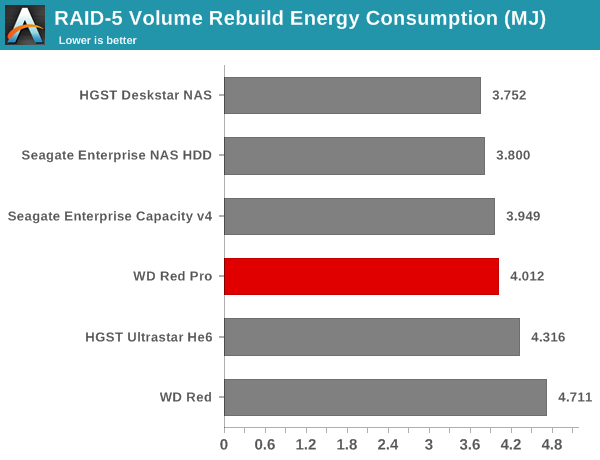
While the energy consumption aspect provides a consolidated view of the various factors, it is still worthwhile to look at the power consumption and resync duration numbers separately. The table below provides the raw information behind the above graph. While the resync duration for the Red Pro is the lowest, the power consumption during the process was also the highest amongst all the evaluated drives. The nett result is that the drive comes in the middle of the pack when it comes to energy efficiency.
| RAID-5 Resync Power Consumption & Duration | ||
| Drive | Power (W) | Duration (s) |
| WD Red Pro | 111.9 | 35850 |
| Seagate Enterprise Capacity v4 | 105.42 | 37462 |
| Seagate Enterprise NAS HDD | 101.91 | 37284 |
| HGST Deskstar NAS | 101.46 | 36981 |
| HGST Ultrastar He6 | 95.36 | 45260 |
| WD Red | 90.48 | 52072 |
We also measured power consumption during the last stage of our multi-client test. With 25 different clients simultaneously stressing the NAS with different types of workloads, we recorded the power consumption at the wall for the NAS as a whole. The various numbers are presented in the graphs below.
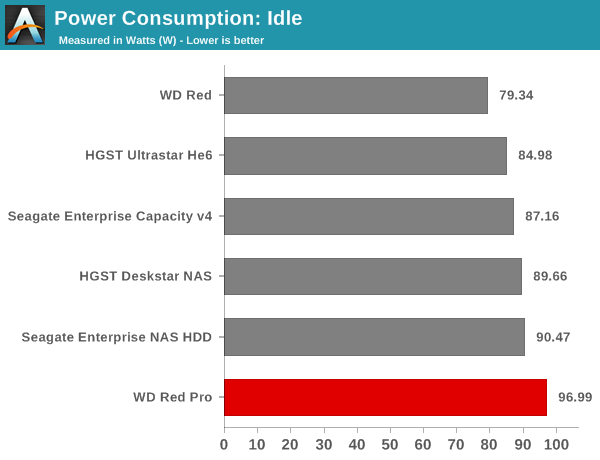
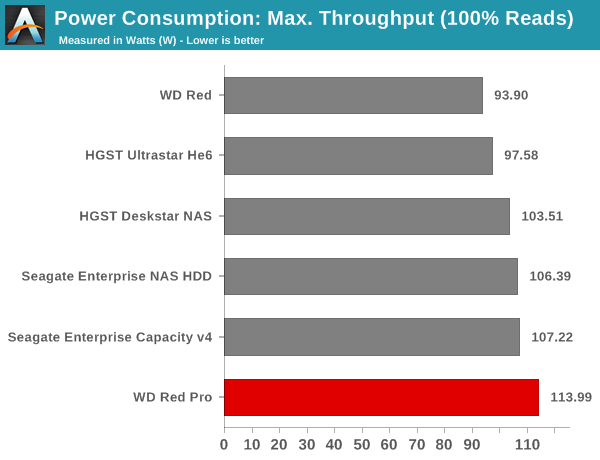
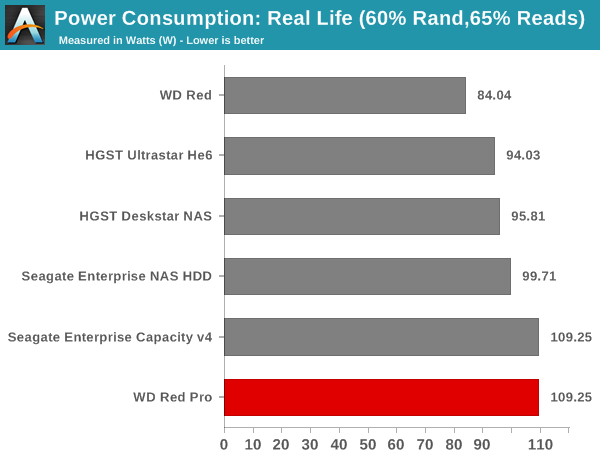
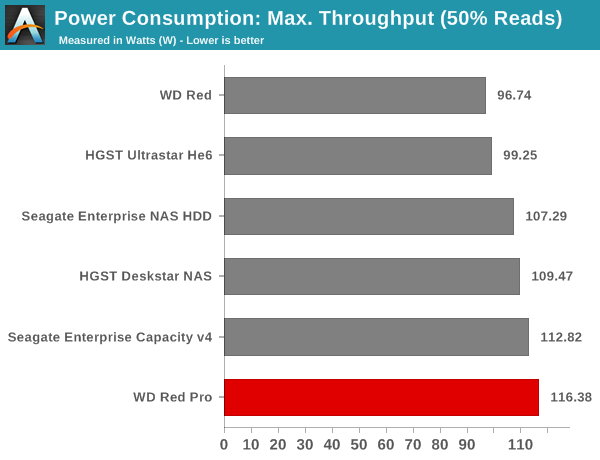
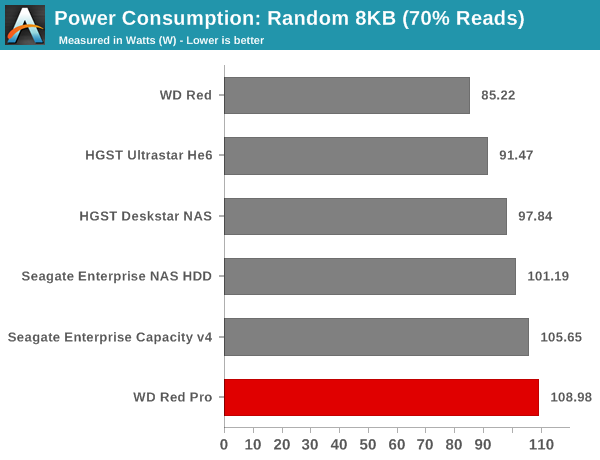
The WD Red Pro is simply not the most power-efficient NAS drive that we have evaluated. Except for the 5400 RPM WD Red, all the other drives that we have in the graphs above are 7200 RPM drives. Despite that fact, the WD Red Pro has the highest average power consumption for all our workloads. However, for a given fixed set of transactions, we expect that the energy efficiency of the WD Red Pro will not be at either extreme (similar to the RAID resync scenario).










62 Comments
View All Comments
MHz Tweaker - Wednesday, September 9, 2015 - link
My findings are that Backblaze statistics are RIGHT on target. In fact they may be too kind to Seagate. I threw 12 Seagate drives in the trash this spring that were 1.5, 2 and 3TB capacities with 3tb drives being the worst drives I have ever come in contact with. I would say that my 3TB Seagate drive failures are higher than 75% in 24 months. I own a service and repair company and observe Seagate drives fail in droves, particularly the 3TB ones. Seagate 4tb drives are vastly more reliable so far but I stopped buying Seagate drives PERIOD because of the thousands of dollars I lost dealing with them. My primary drive is HGST now. I have a couple dozen of their 4, 5 and 6TB NAS drives in a pair of Win 2012R2 servers and a X99 Workstation. I also use them in client servers and workstations for backup images. In 3 years I have yet to have a HGST drive fail or even receive a D.O.A. Great drives.Wwhat - Monday, September 7, 2015 - link
Formerly know as 'deathstar' when still owned by IBM due to consistent early failure, I don't get that they didn't change the name.Personally I don't trust 'consumer reviews' blindly, because there is massive cheating with paid fake reviews on the internet, and because each person has its own usage pattern and perhaps a good experience with a brand is based on a use quite dissimilar to mine.
melgross - Monday, September 7, 2015 - link
I only recall IBM having one particular drive that had a problem. Long time ago, and I don't remember the model, but it was a 75GB unit.bigboxes - Monday, September 7, 2015 - link
I had 6 of those 60GB "Deathstar" drives and each and every one of them eventually failed with the "click of death". I was able to RMA them under warranty and every one failed except for one which is sitting in a box somewhere.bigboxes - Monday, September 7, 2015 - link
75GXP and 60GXP were the bad models.Samus - Monday, September 7, 2015 - link
^ this. The first-generation giant magneto resistant (GMR) heads were not reliable. This hasn't been an issue for a decade. IBM/Hitachi/HGST-Toshiba has changed hands so many times (not owned by WD) that very little IBM technology, if any at all, remains in these new drives.Wwhat - Wednesday, September 9, 2015 - link
I posted my deahtstar remark as a reply to a comment about the deskstar, and am aware it's not a WD company.I have no idea why it did not show up as a reply, probably the poorly codedantiquated comment system to blame?
And my primary point is that it's odd that the company changed name twice but they kept that name with which people had bad memories, it's simply a weird thing to do.
Samus - Thursday, September 10, 2015 - link
It's a pretty good name. The same reason Ford brought back the Taurus nameplate. Even though it was associated with a crappy product at the end of its run, it still has good history behind it.Kjella - Tuesday, September 8, 2015 - link
The IBM Deskstar 75GXP series, but it had six models with 15/20/30/45/60/75GB capacity. Personally I had a 45GB drive die to the "click of death".Souka - Tuesday, September 8, 2015 - link
I think I had a number of these drives....they were the fastest around (or most performance per$$)